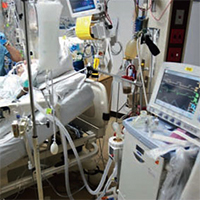Value of modified Burns Wean Assessment Program scores in the respiratory intensive care unit: An Egyptian study
Keywords:
Modified Burns Wean Assessment Program scores, respiratory, ICU, Egypt, weaningAbstract
Background: There is no consensus on the most useful predictive indicator for weaning patients from mechanical ventilation (MV). We aimed to evaluate the utility of the modified Burns Wean Assessment Program (m-BWAP) in predicting the weaning success in patients with respiratory disorders admitted to the respiratory intensive care unit (RICU).
Methods: Patients with respiratory failure requiring MV for longer than 48 hours were included. They were weaned by pressure support ventilation and spontaneous breathing trails. Patients were divided into successful and unsuccessful weaning groups according to their outcomes.
Results: A total of 91 patients were enrolled. The majority had chronic obstructive pulmonary diseases (COPD); 40%, overlap syndrome (24%), and obesity hypoventilation syndrome (OHS): 15%. The successful group had significantly higher m-BWAP scores than that in the unsuccessful group (median 65; range 35 to 80 vs median 45; range 30 to 65; p=0.000), with area under the curve (AUC) of 0.854; 95% CI 0.766 to 0.919), p<0.001. At cut-off value of ≥55, the sensitivity and specificity of m-BWAP to predict successful weaning were 73.77% and 84.85%, respectively. The AUC for m-BWAP was significantly higher than that for rapid shallow breathing index (RSBI).
Conclusion: We conclude that m-BWAP scores represent a good predictor of weaning success among patient with chronic respiratory disorders in the RICU. The m-BWAP checklist has many factors that are closely related to the weaning outcomes of patients with chronic respiratory disorders. Further, large-scale, multicenter studies are warrented.
References
Boles JM, Bion J, Connors A, Herridge M, Marsh B, Melot C, et al. Weaning from mechanical ventilation. Eur Respir J 2007;29:1033-56.
Hussein K, Mohamed S, Ahmed Y. Airway pressure release ventilation in management of acute respiratory distress syndrome: a 2-years experience from upper Egypt. Int J Sci Res 2015;4:265-8.
Keykha A, Dahmardeh AR, Khoshfetrat M. Comparison of success rate of weaning from mechanical ventilation using Burn’s Wean Assessment Program and routine method. Crit Care Nurs J 2017;10:e12557.
Jeong ES, Lee K. Clinical application of modified burns wean assessment program scores at first spontaneous breathing trial in weaning patients from mechanical ventilation. Acute Crit Care 2018;33:260-8.
Ely EW, Meade MO, Haponik EF, Kollef MH, Cook DJ, Guyatt GH, et al. Mechanical ventilator weaning protocols driven by nonphysician health-care professionals: evidence-based clinical practice guidelines. Chest 2001;120:454S–63S.
Esen S, Leblebicioglu H. Prevalence of nosocomial infections at intensive care units in Turkey: a multicentre 1-day point prevalence study. Scand J Infect Dis 2004;36:144-8.
Macintyre NR. Evidence-based assessments in the ventilator discontinuation process. Respir Care 2012;57:1611-8.
McConville JF, Kress JP. Weaning patients from the ventilator. N Engl J Med 2012;367:2233-9.
Baptistella AR, Sarmento FJ, da Silva KR, Ferla Baptistella S, Taglietti M, Zuquello RA, et al. Predictive factors of weaning from mechanical ventilation and extubation outcome: A systematic review. J Crit Care 2018;48:56-62.
Vassilakopoulos T, Zakynthinos S, Roussos Ch. Respiratory muscles and weaning failure. Eur Respir J 1996;9:2383-400.
Burns SM, Marshall M, Burns JE, Ryan B, Wilmoth D, Carpenter R, et al. Design, testing, and results of an outcomes-managed approach to patients requiring prolonged mechanical ventilation. Am J Crit Care 1998;7:45-57.
Jiang JR, Yen SY, Chien JY, Liu HC, Wu YL, Chen CH. Predicting weaning and extubation outcomes in long-term mechanically ventilated patients using the modified Burns Wean Assessment Program scores. Respirology 2014;19:576-82.
Global Initiative for Chronic Obstructive Lung Disease [Internet]. Global Strategy for the diagnosis, management and prevention of COPD 2017. Available from: https://goldcopd.org/
Flenley DC. Sleep in chronic obstructive lung disease. Clin Chest Med 1985;6:51-61.
Mokhlesi B, Kryger MH, Grunstein RR. Assessment and management of patients with obesity hypoventilation syndrome. Proc Am Thorac Soc 2008;5:218-25.
Knaus WA, Draper EA, Wagner DP, Zimmerman JE. APACHE II: a severity of disease classification system. Crit Care Med 1985;13:818-29.
Perkins NJ, Schisterman EF. The inconsistency of “optimal” cutpoints obtained using two criteria based on the receiver operating characteristic curve. Am J Epidemiol 2006;163:670-5.
Wu YK, Kao KC, Hsu KH, Hsieh MJ, Tsai YH. Predictors of successful weaning from prolonged mechanical ventilation in Taiwan. Respir Med 2009;103:1189-95.
Shin HJ, Chang JS, Ahn S, Kim TO, Park CK, Lim JH, et al. Clinical factors associated with weaning failure in patients requiring prolonged mechanical ventilation. J Thorac Dis 2017;9:143-50.
Verbraecken J, McNicholas WT. Respiratory mechanics and ventilatory control in overlap syndrome and obesity hypoventilation. Respir Res 2013;14:132.
Mohamed S, Bayoumi H, Abd El-Aziz N, Mousa E, Gamal Y. Prevalence, risk factors, and impact of lung Cancer on outcomes of idiopathic pulmonary fibrosis: a study from the Middle East. Multidiscip Respir Med 2018;13:37.
Weitzenblum E, Chaouat A, Kessler R, Canuet M. Overlap syndrome. Obstructive sleep apnea in patients with chronic obstructive pulmonary disease. Proc Am Thorac Soc 2008;5:237-41.
Alía I, Esteban A. Weaning from mechanical ventilation. Crit Care 2000;4:72-80.
Burns SM, Fisher C, Tribble SE, Lewis R, Merrel P, Conaway MR, et al. The relationship of 26 clinical factors to weaning outcome. Am J Crit Care 2012;21:52-8; quiz 59.
Dehghani A, Abdeyazdan G, Davaridolatabadi E. An overview of the predictor standard tools for patient weaning from mechanical ventilation. Electron Physician 2016;8:1955-63.
Blackwood B, Alderdice F, Burns K, Cardwell C, Lavery G, O'Halloran P. Use of weaning protocols for reducing duration of mechanical ventilation in critically ill adult patients: Cochrane systematic review and meta-analysis. BMJ 2011;342:c7237.

Published
Issue
Section
License
Mattioli 1885 has chosen to apply the Creative Commons Attribution NonCommercial 4.0 International License (CC BY-NC 4.0) to all manuscripts to be published.




